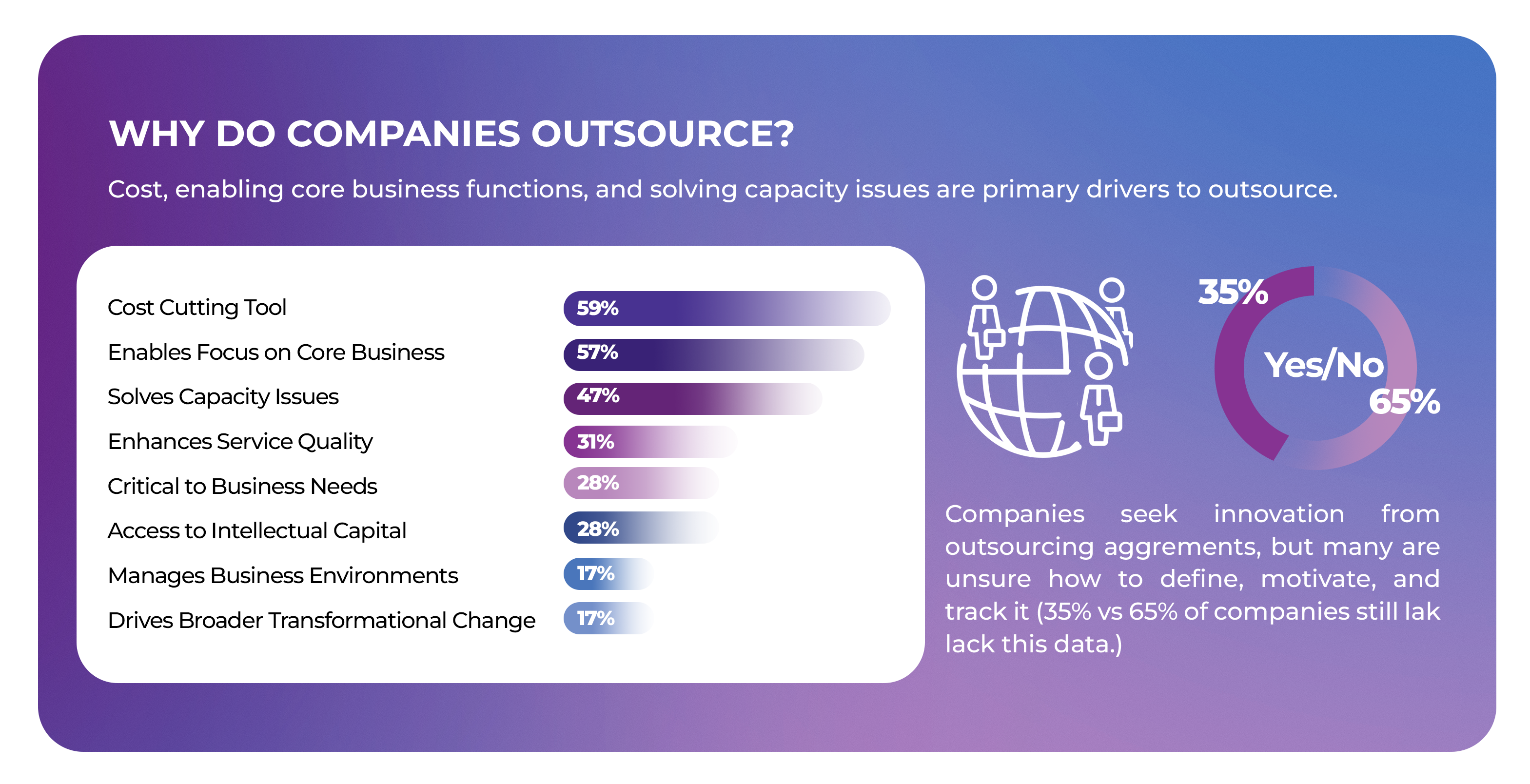In the quest to stay competitive and meet customers’ changing needs, businesses are constantly looking for new and innovative ways to improve their products, processes, and strategies while effectively managing costs and resources. Innovation is beyond mere invention; it involves a wide range of creative pursuits, from pioneering revolutionary technologies to reinventing business models and fostering a culture of continuous improvement. From Silicon Valley tech to small local businesses, the ability to innovate has evolved from a competitive advantage to a vital requirement for thriving in the modern marketplace.
The synergy between innovation and outsourcing holds the potential to increase efficiency and develop ground-breaking ideas and a business strategy that can launch businesses to new heights. This article explores the intricate relationship between the two concepts, uncovering how they can drive growth, agility, and sustainable success.

The Fusion of Innovation and Outsourcing
Outsourcing can foster innovation by providing businesses access to specialized talents, cutting-edge technologies, and diverse perspectives. When companies outsource innovation-specific operations, they can tap into a global talent pool, bringing in individuals with unique knowledge and experiences. The inflow of outside ideas can promote creativity and bring new ideas into the company’s innovation processes. Additionally, outsourcing enables businesses to focus on their core strengths while delegating non-essential tasks to specialists. This focus on strategic areas often improves efficiency, freeing up internal resources for more innovative projects. Furthermore, because service providers are often at the forefront of advances in their respective fields, outsourcing provides exposure to the latest technologies and industry best practices.
Risks and Challenges
While outsourcing can help with innovation, it also introduces new risks and challenges that companies must carefully consider. One significant concern is the potential loss of control over sensitive information and intellectual property. Sharing propriety knowledge with external partners may expose companies to the risk of leaks or unauthorized use. Moreover, cultural and communication differences between in-house teams and external providers might lead to misunderstandings, affecting the quality and alignment of innovative efforts.
Another challenge is the dependency on third-party providers, as disruptions in their operations or financial instability may hinder the timely delivery of solutions. To reduce this risk, businesses must carefully evaluate the reliability and resilience of their outsourcing partners.
Further, regulatory compliance and legal issues might present difficulties when innovation outsourcing involves handling sensitive data or operating in highly regulated industries. It is critical to ensure that external partners comply with legal and ethical standards to avoid potential legal issues.
To mitigate these risks and challenges, outsourcing companies must establish strong contractual agreements, conduct thorough due diligence when selecting partners, implement stringent security measures, and balance internal and external innovation capabilities.
Strategies for Leveraging Innovation and Outsourcing
1. Identifying areas for innovation within your organization
Businesses can effectively leverage the power of outsourcing and innovation by first identifying areas for innovation within the organization. It is essential to foster a culture of creativity and cross-functional collaboration, encouraging employees to contribute innovative ideas. Creating specialized R&D efforts enables the exploration of emerging technologies and industry trends. Seeking external collaborations with startups, research institutions, and industry partners promotes a diverse and innovative approach. At the same time, companies can identify non-core functions that can be outsourced to specialized partners, allowing them to focus on core competencies.
2. Selecting the right outsourcing partners
Companies can use outsourcing to their advantage by heavily emphasizing the selection of the right outsourcing partner. The key is a thorough screening process considering experience, reputation, scalability, and cultural compatibility factors. Comprehensive due diligence ensures that the chosen partner is aligned with the organization’s objectives and has the expertise to provide high-quality services. A strategic alignment of the outsourcing partner’s competencies with the organization’s objectives ensures a collaborative and mutually beneficial relationship. Businesses may tap into external expertise, improve productivity, and drive innovation by selecting partners carefully.
3. Establishing a culture of innovation within your company
This involves creating an environment that will support innovation, risk-taking, and employee collaboration. Leadership is critical in fostering and rewarding innovative ideas and establishing an environment where people feel empowered to propose novel solutions. Establishing a research and development (R&D) program enables the exploration of emerging technologies and industry trends. The adoption of agile processes enables a quick response to changing market demands. In the quest for cutting-edge innovation, businesses have the opportunity to not only cultivate internal idea generation by ingraining an innovative culture into their organizational DNA but also to outsource tasks strategically. Organizations can complement and amplify their innovation efforts by identifying the optimal areas for outsourcing, creating a synergic approach that combines internal creativity with external expertise.
4. Implementing effective communication and collaboration between in-house and outsourced teams
Developing clear channels for information exchange and keeping lines of communication open helps bridge possible gaps between internal and external teams. Regular meetings and using collaboration technologies build a sense of unity, ensuring that both teams are on the same page with project objectives and timelines. Emphasizing a shared knowledge of the company’s goals and objectives contributes to developing a collaborative culture that transcends geographical boundaries. Businesses can harness the capabilities of in-house expertise and outsourced specialized skills by supporting a smooth flow of information, resulting in more efficient operations, accelerated innovation, and, eventually, increased overall productivity.
Overcoming Common Challenges
Addressing security and confidentiality concerns
Information security becomes increasingly important as companies entrust sensitive data and crucial operations to external partners. This is especially true in an environment where cyber threats are rising and regulatory data protection requirements are becoming stricter. Here are some solutions to these challenges:
- To handle security and confidentiality concerns in outsourcing, draft detailed contracts with defined data protection protocols, encryption standards, and access controls.
- Conduct extensive due diligence, assessing the outsourcing partner’s security measures, certifications, and track record in managing sensitive data.
- To legally bind the outsourcing partner to maintain confidentiality, implement non-disclosure agreements with explicit consequences for breaches.
- Enforce strong data encryption and rigorous access controls for sensitive data in transit and storage.
- Develop a comprehensive incident response plan that outlines the steps to be taken in the event of a security breach and ensure that both parties are aware of it.
Managing cultural and geographical differences in outsourcing partnerships
As organizations increasingly engage in global collaborations, the capacity to navigate multiple cultural landscapes and overcome geographic gaps becomes increasingly important in ensuring operational synergy. This requires a proactive approach that includes developing cultural awareness, employing effective communication strategies, and encouraging flexibility. The following strategies offer insights into addressing the challenges caused by cultural and geographical differences:
- Encourage cultural awareness through education and training to close knowledge gaps between diverse teams.
- Establish open communication channels, using technology to enable real-time collaboration and reduce the impact of geographical differences.
- Encourage cross-cultural team-building activities and initiatives to foster a sense of unity and shared goals.
- To avoid misunderstandings, define clear expectations and standards for communication, project updates, and decision-making.
- Processes should be flexible and adaptable, recognizing and accommodating different working styles and cultural norms.
Dealing with potential resistance to change within the organization
Navigating the outsourcing landscape often involves organizational changes that can be met with internal resistance. Addressing and overcoming any pushback is critical for successfully implementing outsourcing innovation. The following strategies can help organizations effectively manage internal challenges and develop a culture conducive to successful outsourcing implementation:
- Conduct extensive change impact assessments to identify potential issues and address them beforehand.
- Transparently communicate the rationale behind outsourcing initiatives to minimize employee fears and uncertainties.
- Provide training programs to employees to equip them with the skills required to adapt to new processes and technologies.
- Establish a change management team to handle concerns, gather feedback, and ensure a smooth transition.
- Celebrate small victories and share success stories to boost confidence and demonstrate positive outcomes from outsourcing changes.
Best Practices for Sustainable Competitiveness
Continuous improvement and adaptation
Sustainable competitiveness in outsourcing requires a strategic approach that includes continual improvement and flexibility. Organizations must navigate changing market trends, technological breakthroughs, and shifting business priorities in global business partnerships. Here are key practices to ensure that the outsourcing arrangements remain resilient and aligned with organizational goals:
- To successfully monitor and measure the success of outsourcing relationships, define performance metrics and key performance indicators (KPIs).
- Regularly monitor outsourcing partner’s performance through structured reviews, encouraging open communication to address difficulties and suggest opportunities for improvement.
- Contracts should have built-in flexibility to accommodate changing business needs, ensuring that outsourcing agreements can quickly adjust to market dynamics.
- Proactively identify and manage risks, create contingency plans, and regularly review and renew outsourcing contracts to ensure continued alignment with business objectives.
Balancing innovation and cost efficiency
As businesses increasingly rely on outsourcing to achieve competitive advantage, creating an environment that fosters innovation while keeping a watchful eye on cost-effectiveness is critical. The following practices highlight crucial measures for achieving this delicate balance.
- Implement strategic innovation initiatives within the outsourcing framework to improve processes, services, and overall value delivery.
- Adopt cost-effective technologies that improve operational efficiency, eliminate manual tasks, and contribute to cost reductions while maintaining quality.
- Adopt agile project management methodologies to facilitate flexibility, faster adaptability to changing requirements, and more efficient communication between in-house and outsourced teams.
- Promote collaborative problem-solving between internal and external teams, creating an environment where innovative solutions can be developed without incurring additional costs.
Building a flexible and resilient business model
Organizations seeking long-term successful innovation and outsourcing must adapt to changing market conditions, technological advancements, and unforeseen challenges. These best practices stress the significance of adaptability and resilience in developing outsourcing strategies that can withstand the complexities of the modern business environment:
- Develop agile contract structures that allow for changes based on changing business needs, ensuring service scope, scale, and duration flexibility.
- Encourage cross-training initiatives between internal and external teams to develop a versatile workforce capable of handling various tasks and challenges.
- Integrate digital transformation projects into outsourcing operations to improve operational efficiency, enable remote collaboration, and protect the company against technological shifts.
- Conduct scenario planning exercises and comprehensive risk management to anticipate potential disruptions and enable proactive responses to mitigate negative consequences.
The synergy between innovation and outsourcing is a significant catalyst for maintaining a competitive edge in the business landscape. The complex dance between them not only unlocks cost efficiencies but also generates new solutions and drives business growth. As organizations manage this delicate balance. By strategically leveraging each to reinforce the other, businesses can achieve successful innovation outsourcing, securing a distinct competitive advantage that propels them forward in a dynamic and competitive landscape.



Leave A Comment
You must be logged in to post a comment.